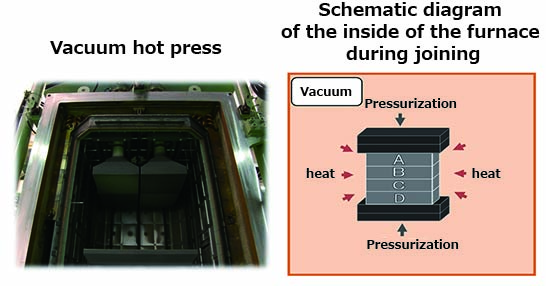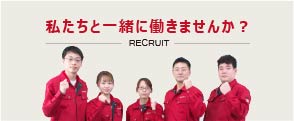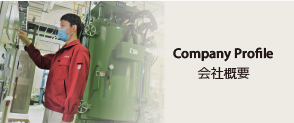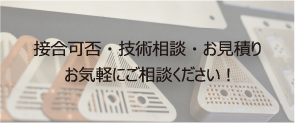- Home
- What is Diffusion Bonding?(拡散接合とは?)
What is Diffusion Bonding?(拡散接合とは?)
What is Diffusion Bonding? Precision jig / parts High cycle mold
What is Diffusion Bonding?
Diffusion bonding technology does not use adhesives and enables the manufacturing of original parts with complex shapes and miniscule sizes.
What is the Japanese Industrial Standard’s (JIS) Definition of Diffusion Bonding?
It is defined as “a method of adhesion where the temperature is brought to below the melting point of the base metal and applying pressure to the base material to the extent that plastic deformation is minimized then using the diffusion of atoms generated between the joining surfaces to bond the materials.”
Diffusion Bonding Technology Expands the Possibilities of Manufacturing
Join surfaces without relying on inclusions such as adhesives. This technology infinitely expands the possibilities of manufacturing jigs, machine parts, and hollow parts with complicated structures. Since our establishment in 1990, we been working hard to establish this dream-like technology.
Unlike welding, joins are made without melting the base metal, so it is suitable for manufacturing products that require high precision and very small parts.
In addition, since no adhesive (wax, etc.) is used, gas that could cause interference is not produced.
Yamatech’s diffusion bonding (thermocompression bonding) technology can bond various materials, such as similar metals or dissimilar metals, at the atomic level using heat. We take pride in responding to our customers’ increasingly sophisticated product needs, demand for complicated shapes and minuscule sizes. We are confident we can assist in creating new possibilities for our customers’ businesses.
Responding to the needs of engineers
Diffusion bonding (thermocompression bonding) technology has long been an aspiration of the engineering world, but it is said that it is difficult to stabilize this technology. Yamatech considers its past failures valuable data. Focusing on stainless steel [SUS] in general, nickel-based [Ni], copper-based [Cu], aluminum alloy [Al], titanium [Ti], etc., Yamatech has succeeded in the diffusion bonding (thermocompression bonding) of various metals through a long process of trial and error. Currently, we are building a framework to provide our customers with consistent quality products. While continuing to challenge ourselves to join other varieties of metals, we are working tirelessly to meet the diverse needs of engineers.

The materials are brought very close together, then heat and pressure are applied to start the diffusion process.
In order to minimize distortion and deformation, the optimum temperature and pressure are set according to each material and shape.

By using heat and pressure, the metal atoms on the joint’s surface mix and the gaps between them gradually disappear. When the diffusion bonding process is complete, the bonding interface cannot be identified even by observing a cross section.
Types of Metals Commonly Used in Diffusion Bonding:
Mainly stainless steel [SUS]
・ Nickel-based [Ni]
・ Copper-based [Cu]
・ Aluminum alloy [Al]
・ Titanium [Ti]
・ Other metals
It is possible to join various metals with diffusion bonding.
We can also join dissimilar materials such as stainless steel and copper.
Merits of Diffusion Bonding
・Surface-to-surface joining
Since the bonding process is done using a surface instead of a point or line, there is no concern that the bond will break during subsequent processing (tapping, raising, bending, etc.).
・Precision work can be done in micron (μm) units
We have the capability to laminate and join ultra-fine parts produced using photo-etching technology without displacement or distortion.
Also, using data we have accumulated, we can set appropriate conditions for each material and manufacture products that require accuracy.
・Compactness and precision products (parts) (regarding various sizes and shapes)
Yamatech has a stock of special jigs to match products of all sizes.
A 4-axis hot press has also been added to handle large sizes that are difficult for other companies.
With this press, it’s possible to join pieces up to 1000 x 1000 mm.
・Manufacturing parts with complicated structures that could not be made until now
By stacking multiple metal plates, we are now able to create complex shapes and flowing path structures that are difficult to make with metal processing techniques like cutting.
Yamatech addresses each customer’s needs with a unique technology that bonds metal to metal.
The problem that customers are having now may be solved by diffusion bonding. We work with engineers to create products, so in addition to inquiries about specific details, we welcome inquiries about products still at the concept stage and the feasibility of products, so please feel free to contact us.
Yamatech’s skills in “metal-to-metal joining”
It’s a simple idea, but advanced expertise and technology are crucial to successfully create highly-precise complex shapes that can be used in various applications without the bonded surface peeling off.
At Yamatech, we create a special environment of temperature and pressure according to the characteristics of the metal, and cause atomic-level diffusion to achieve a perfect bond.
Using this industrial science in practical applications is known as “diffusion bonding”.
From Bonding Condition Analysis to mass production
The conditions that enable diffusion bonding are extremely specific. For example, even with the same “SUS304″ grade stainless-steel sheet, the results will vary slightly depending on the material’s manufacturer and the lot used. What becomes important is our data compiled over many years through trial and error. From the bonding condition analysis stage, the materials used, parts to be produced, the application of the parts, the environment in which they are used, to the lineup that realizes mass production, Yamatech has an adaptable system in place to quickly respond to customer needs.



